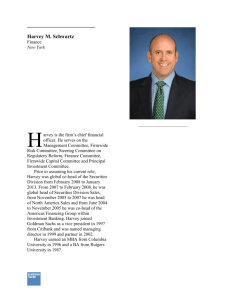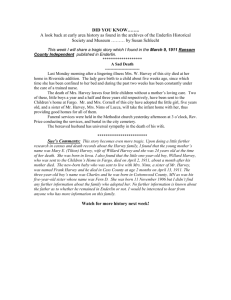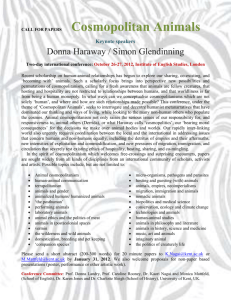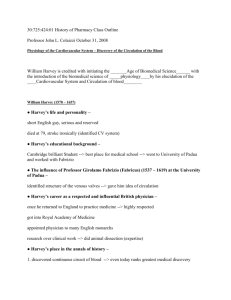book review of David Harvey - Institute for Advanced Studies in Culture
advertisement
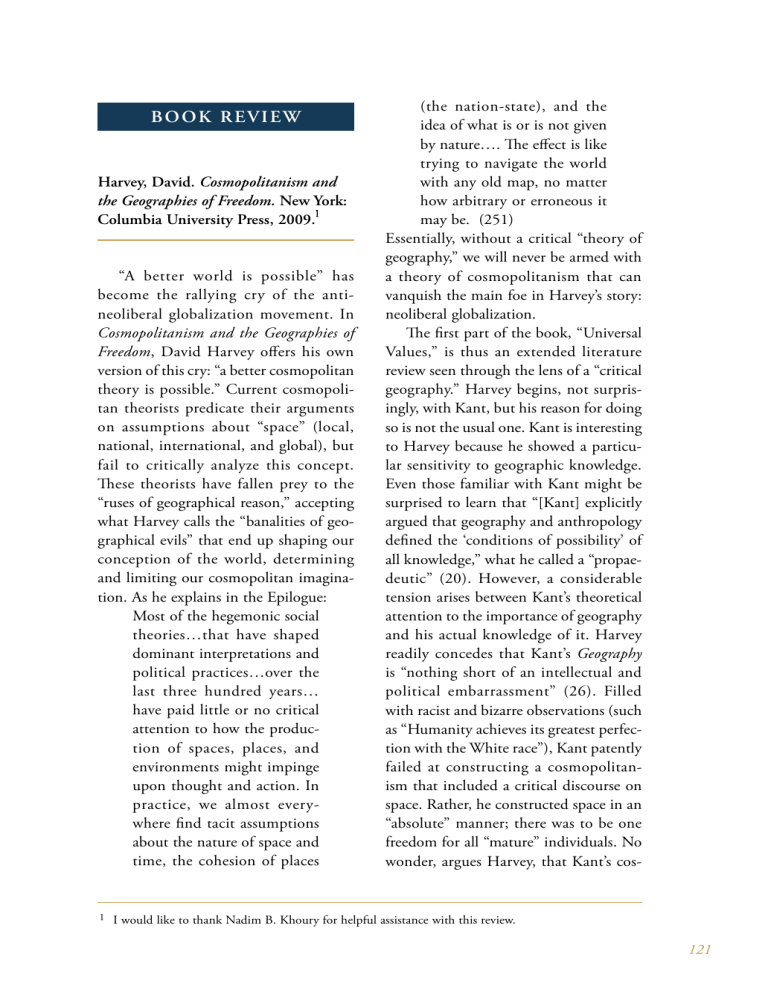
Book Review Harvey, David. Cosmopolitanism and the Geographies of Freedom. New York: Columbia University Press, 2009. “A better world is possible” has become the rallying cry of the antineoliberal globalization movement. In Cosmopolitanism and the Geographies of Freedom, David Harvey offers his own version of this cry: “a better cosmopolitan theory is possible.” Current cosmopolitan theorists predicate their arguments on assumptions about “space” (local, national, international, and global), but fail to critically analyze this concept. These theorists have fallen prey to the “ruses of geographical reason,” accepting what Harvey calls the “banalities of geographical evils” that end up shaping our conception of the world, determining and limiting our cosmopolitan imagination. As he explains in the Epilogue: Most of the hegemonic social theories…that have shaped dominant interpretations and political practices…over the last three hundred years… have paid little or no critical attention to how the production of spaces, places, and environments might impinge upon thought and action. In practice, we almost everywhere find tacit assumptions about the nature of space and time, the cohesion of places 1 (the nation-state), and the idea of what is or is not given by nature…. The effect is like trying to navigate the world with any old map, no matter how arbitrary or erroneous it may be. (251) Essentially, without a critical “theory of geography,” we will never be armed with a theory of cosmopolitanism that can vanquish the main foe in Harvey’s story: neoliberal globalization. The first part of the book, “Universal Values,” is thus an extended literature review seen through the lens of a “critical geography.” Harvey begins, not surprisingly, with Kant, but his reason for doing so is not the usual one. Kant is interesting to Harvey because he showed a particular sensitivity to geographic knowledge. Even those familiar with Kant might be surprised to learn that “[Kant] explicitly argued that geography and anthropology defined the ‘conditions of possibility’ of all knowledge,” what he called a “propaedeutic” (20). However, a considerable tension arises between Kant’s theoretical attention to the importance of geography and his actual knowledge of it. Harvey readily concedes that Kant’s Geography is “nothing short of an intellectual and political embarrassment” (26). Filled with racist and bizarre observations (such as “Humanity achieves its greatest perfection with the White race”), Kant patently failed at constructing a cosmopolitanism that included a critical discourse on space. Rather, he constructed space in an “absolute” manner; there was to be one freedom for all “mature” individuals. No wonder, argues Harvey, that Kant’s cos- I would like to thank Nadim B. Khoury for helpful assistance with this review. 121 T he H edgehog R eview / fall 2 0 0 9 mopolitan world of liberal democratic states had such a circumscribed right to cross borders and reside in other countries: in Kant’s mind, the world was filled with “unwashed Hottentots” and “thieving Javanese” (27). Carrying with him Kant’s idea of a “propaedeutic,” but not Kant’s actual geographic prejudices, Harvey moves on to the postcolonial critique of liberal cosmopolitanism, which, along with communitarianism, held out the promise of improving upon liberal theory by being more sensitive to the particularities of space. By engaging in “relational space” as opposed to the absolute Newtonian/ Cartesian space of liberal theory, theirs is a “cosmopolitanism of sentiments,” recognizing “the psychological and cognitive operations through which place comes to acquire its crucial relation to identity,” as Uday Singh Mehta puts it (building on Burke) (43). Harvey argues that such critics unfortunately end up representing the other extreme on the liberalcommunitarian continuum, fetishizing the local to the point of exclusionary communitarianism or even local fascism. Furthermore, when postcolonialist theory takes for granted spatial entities such as India, itself a colonial invention, they end up perpetuating uncritical spatial definitions (49). But again, neoliberalism is the main target of Harvey’s capacious critique. Moving on to current day neoliberal cosmopolitanism, Harvey, using his Marxist lens, critiques the way neoliberalism creates a particular kind of space through an ideological discourse, summed up in Thomas Friedman’s famous phrase “the world is flat” (57). That neoliberalism produces uneven geographical develop122 ment is clear, but less clear is the way it uses uneven geographical, anthropological, and ecological developments (including those it produces) as means to promote the universality of its own world project, which has nothing to do with the well-being of the whole of humanity but everything to do with the enhancement of its own dominant forms of class power. (65) “New Cosmopolitanism,” as Harvey terms it, is a response to and an attempt to fix the faults of neoliberalism. Unfortunately, these authors not only do not go far enough; they too often end up abetting the neoliberal framework. For instance, their admiration for the European Union as a cosmopolitan project is misplaced, as it is mainly a neoliberal project aimed at increasing economic profits (83). Furthermore, their theories lack practical solutions (92). This is not due to utopianism on their part, but rather a result of their buying into the “flat” space of neoliberalism. For instance, David Held is criticized for superficially proposing a “‘layered cosmopolitanism’ reflective of local, national, and regional affiliations,” without making any attempt at understanding “how this layering is actually produced and at what scales” (85). Unless the new cosmopolitanists incorporate a critical discourse on space into their theories, they will fail at implementing their new cosmopolitan projects, concludes Harvey. The contribution of Harvey’s literature review is not the well-known objections to the theories it treats, but rather his fresh angle of “critical geography.” He focuses the reader on interesting shortcomings of B ook R eview the current theories of cosmopolitanism and even alerts us to unintended symmetries between neoliberalism and “new cosmopolitanism.” In the end, all the current theories are weighed and found to be too light to stand up to neoliberalism. What is needed is a critical discourse on geography, he reiterates, in order to achieve a cosmopolitanism that rejects the “ruses of geographical reason.” The second part of Harvey’s book is thus titled “Geographical Knowledges” and aims at developing this “critical geographical theory.” But what does Harvey mean by this? As Harvey himself asks on the very last page of the very last chapter, “what kind of geographical and ecological knowledge is required for the adequate formulation of a cosmopolitan project?” (247). Unfortunately, Harvey continues restating the question in the Epilogue while holding any clear answers tightly to his chest. Indeed, after having read the chapters where Harvey explores the three concepts important to his critical theory of geography (environment, spacio-temporality, and place and region), one is struck not by an epiphany of how to better construct geographies of freedom (which would be difficult, as this term is left unexplained throughout the book), but rather by the nigh impenetrable complexity of—his theory, yes, but also—his language. It might thus be helpful to state what the theory is not. Approaches that do not recognize the dialectical nature of geography and politics are unacceptable. He takes Jared Diamond (Guns, Germs, and Steel) and Jeffrey Sachs (The End of Poverty) to task for their environmental determinism. Harvey’s answer, rather, is a dialectical, process-based, and interactive approach to world historical geography, a “revolutionary geographical theory.” The question “what is space” must be replaced by the question “how is it that different human practices create and make use of different conceptualizations of space?” (140). Indeed, the clear analytical separation between “man,” “nature,” and “environment” must be rejected. Harvey uses Hurricane Katrina as an example: There is no such thing as a purely natural disaster. The tragedy of New Orleans in 2005 was not simply the effect of Katrina; it was also the product of socio-political and economic circumstances (215). That claim seems reasonable, but also fairly obvious. After reading the book, the question still remains: exactly how is a critical awareness of “spacetime” (as he calls it), place, and environment relevant to a better cosmopolitanism? Is it because “working-class and popular movements have to pay more attention to geopolitical and universal strategies” in order 123 T he H edgehog R eview / fall 2 0 0 9 to avoid outside suppression (195)? Or perhaps because there must be a dialectical relationship between the local and the universal (196)? The first answer, however, is commonsensical, the second general. Harvey, as it turns out, can be every bit as fuzzy on the practical guidelines as he critiques Martha Nussbaum and David Held of being. Harvey’s complex theory comes with two apparent commitments. His academic commitment is to improve the theorizing on cosmopolitanism through a critical theory of geography. This improved theory should then lead to political results in the form of “liberatory” cosmopolitan politics. However, after having explained the complex conceptual building blocks of his “critical geographical theory,” the reader is still uncertain as to how Harvey means to assemble these into a powerful tool fitted for vanquishing neoliberalism. Exactly how would shifting from an “absolute” conception of space to a relational, dialectical conception of space achieve “global justice” (which Harvey reveals on the last page of the book to be the goal of cosmopolitanism)? In conclusion, Harvey certainly succeeds in furthering the academic debate on cosmopolitanism by crisply introducing an intriguing and original line of critical inquiry. Yet, when Harvey attempts to cash in on his novel approach, things become much more difficult to follow. It is certainly the case that political scientists, sociologists, and other scholars whose job it is to study international affairs and institutions—and who might otherwise be sympathetic, or at least open, to Harvey’s argument—are left on their own to figure out how the details work in practice. Of course, the fact that a book requires effort and attention from 124 its readers, and even that it leaves readers with more questions than when they began, is not necessarily a bad thing. Hilde Eliassen Restad, a graduate student in the University of Virginia’s Department of Politics, is currently a fellow at the Norwegian Institute for Defense Studies and a recipient of the AmericanScandinavian Foundation’s Johan Jørgen Holst Award.
